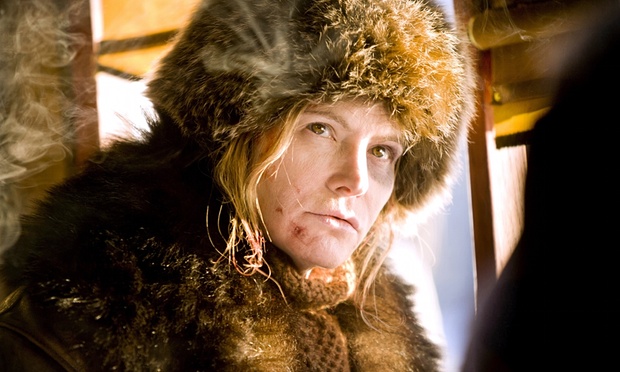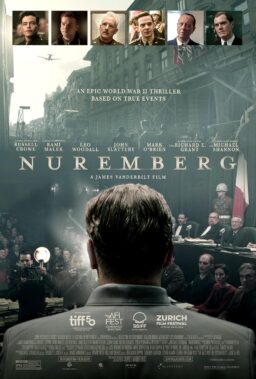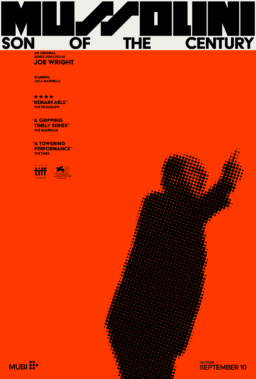I’m in the ladies’ room during the twelve-minute intermission of “The Hateful Eight“; the line of men outside waiting for the bathroom is loud and chattering, but the mood where I’m standing is quieter, more subdued. This may have something to do with what we’ve watched for past hour and a half: the titular octet includes but one woman, the outlaw prisoner Daisy Domergue (Jennifer Jason Leigh), who serves as a literal punching bag for her captor, the bounty hunter John “The Hangman” Ruth. She starts the film with a deep black saucer of bruising around her eye, and, shortly after her introduction, Ruth cracks her on the nose. We hear the snap of her cartilage with the surrealistic clarity of a Looney Tunes classic. This isn’t even the last time she is hit before the group reaches Minnie’s Haberdashery, where the film’s plot, which feels like Agatha Christie does John Carpenter’s “The Thing,” grinds into action. I ask the woman washing her hands next to me how she’s liking the movie. Her curt reply: “I could deal without him hitting her. We get the point already.”
But this is Tarantino, I tell myself. His films are pageants of lovingly articulated carnage. Male and female bodies alike are assaulted with bullets and fists; they are scalped and raped and ribboned with swords. But that violence is always in service to something—it is the catalyst for a roaring rampage of revenge, or an instrument of that revenge. At its most frivolous, it gives us grand “f–k yeah!” moments. And at its most profound, it illustrates, with a broad brush, the horrors of oppression (whether that oppression comes from Nazis or slavers or creepy assholes who think they’re entitled to a pretty girl’s attention). So, I head back into the theater expecting something, even a “f–k yeah!” moment, to, if not redeem Daisy’s suffering, then at least give it some purpose. Though elements of his movies have been deeply problematic (“dead n-word storage” will never be funny to me) I haven’t (until this point) found them to be sexist; if anything, Tarantino has been (at times, and in his own way) a subversively feminist filmmaker.
Tarantino is the man who gave us Beatrix Kiddo punching her way out of a coffin and six feet of hard earth; Shosanna Dreyfus ending the Third Reich with a cackle and a match; and Abernathy Ross axe-kicking a serial killer of women right in the head. Yet, I find that, when the lights came up on “The Hateful Eight,” I don’t come away with any sense of purpose, or a point. I spent three hours watching a kind of gleeful viciousness deployed not only against Daisy, but against the few other women who appear on-screen, and all I have is a bitter, coppery taste in my mouth. Daisy exists to be punched, and to rebound from those punches like Daffy Duck after he’s had his bill blown off. She smiles and scowls with a mouth full of blood, inviting the audience to laugh at her pain. (And the audience I’m with does laugh. Often.) In a movie populated by a Confederate General who massacred Black POWs, a good ‘ol boy who got his jollies raiding towns of freed slaves, and an ex-Union major with no qualms about oral rape (not to mention the gaggle of gun-toting, epithet-slinging outlaws), Daisy is somehow singled out for the most savage treatment—and not only by the men on-screen, but by the man behind the camera.

The film ends on the image of a lynched woman: her face, a monster’s face, blood-caked and swollen, before the noose ever cinches around her neck. Daisy is strung up by Chris Mannix (Walton Goggins), the marauder, and Major Warren (Samuel L. Jackson), who is, if not the movie’s moral center then the smartest, most compelling character, and therefore the de facto focus of the audience’s attention—which gives her murder a sense of legitimacy. When Warren stops Mannix from putting a bullet in her—denying her the quick death that was somehow good enough for the motley bastards who’d actually shot up a saloon full of innocent people—because “when ‘the hangman’ gets you, you hang” he turns her death into a tribute to John Ruth (Kurt Russell), the man who made a grim sport of battering her. Daisy lives and dies by the whims of the men in her life; indeed, she is wholly defined by them: even her bounty is determined by her status as the sister of Jody Domergue (Channing Tatum), the real leader of the gang; and that status alone is what sparks the Domergue gang’s attempted rescue and sets the whole gory story into motion.
If I’d had to make a list of impossible things that could never happen, Tarantino indulging in full-tilt, “Grand Theft Auto“-levels of misogyny would have been right at the top of the list. Even working within traditionally masculine genres—the war movie, the spaghetti Western, the gangster pic, the kung-fu flick—he has crafted women characters who feel as cunning and nuanced, as fiercely intelligent and unabashedly unlikeable, and truly as iconic, as the male standard-bearers of those movies. Uma Thurman’s inscrutably cool and charismatic Mia Wallace appears on the posters for “Pulp Fiction“. Mia’s black bob, air-drawn square (as in “C’mon, daddio, don’t be a square”) and Fox Force Five joke are as integral to the film as Vincent Vega’s black suits and Jules Winfield’s Ezekiel 25:17. And there is a good reason why Tarantino’s adaptation of the pulpy crime novel “Rum Punch” became “Jackie Brown“: When all too many filmmakers believe that any actress over forty can only be the mother of the bride or the sad yet knowing older friend, he gave Pam Grier the chance to play earthy and sexy and smart, to be daring and ruthless and, in the end, triumphant. (Ironically, the casting of 53-year-old Jennifer Jason Leigh in “The Hateful Eight” was part of what initially excited me about that film).
Tarantino’s loving pastiche approach to cinema functions (at its best) as something more than mere tribute. It invites those of us who may have felt left out by particular genres or tropes to wade back in—the water’s fine, since now, finally, we can see our own reflections on the surface. Powerful, self-contained women who are still raw and flawed and bracingly, achingly human now share the silver and small screens—but I can still remember a time before Katniss Everdeen, Imperator Furiosa, and Jessica Jones (and I hope to live in a time when most of the major female protagonists aren’t white). As a teenager, I was an avid Buffy-watcher, but none of the other women action heroes I could recall truly inhabited their own narratives: Sarah Connor may have been fierce, but she was also a vessel for and player in her son, the great Chosen One’s, story. Ellen Ripley blessed us with “get away from her, you bitch!,” but her story is often about raw-knuckled survival, nothing more, nothing less. So, when I was a 21-year-old, sitting in the theater and looking up at Beatrix Kiddo as she cut through hordes of enemies with her Hanzo sword (while wearing Bruce Lee’s legendary yellow and black-striped track suit) I felt something truly transcendent: “Kill Bill” was one of the first movies I’d seen where a woman underwent the traditional hero’s journey. Beatrix’s journey isn’t entirely about dropping bodies, it is also about contemplating the nature and purpose of her own power; hers is a story equally of redemption and revenge. In obliterating the Deadly Vipers, she goes beyond being Bill’s woman, a woman who would jump motorcycle onto speeding train for him, and becomes her own woman.

One more subtle, though no less potent, aspect of the films is that the relationships between Beatrix and most of the vipers is as fraught and complex as her affair with Bill. Elle Driver may want Beatrix to “suffer to her last breath” but she still respects her as “the greatest warrior I’ve ever known.” The brief interactions between Beatrix and O-Ren tease a once-deeper friendship—they even finish each other’s sentences (and “silly rabbit, tricks are for kids,” feels very lived-in, like one of those random asides that somehow becomes a care-worn private joke). After “Kill Bill,” I became a ride-or-die Tarantinoista, defending his work to my fellow feminists who dismissed Mia Wallace as a sad Cool Girl archetype, or claimed that “Death Proof” is just a bonanza of booty shorts and flip-flops. Mia is aware that she is a sad, Cool Girl archetype, and that, instead of becoming a mainstay on the silver screen, she exists as an object of obsession for her husband’s employees. There is genuine pathos in her limitations (Uma Thurman’s rueful line reading of “when you little scamps get together, you’re worse than a sewing circle” always pierces me.) because there is a real woman, who had real ambitions to act, long before Vincent Vega ever worked up the nerve to ask her why Marcellus threw Tony Rocky Horror out of that window. And yes, “Death Proof” features a plethora of babes with shapely feet, but it also shows a surprising insight about certain terrors of being a woman: Stuntman Mike is every Nice Guy™ who expects to be invited home from the bar because he bought you a drink; Kim, the bad-ass stunt driver, admits to carrying a gun because she fears being raped if she goes into the laundry room at midnight; and Abernathy worries that, as a single mother, she’ll be seen as unhip, and left behind by her friends.
Even if Tarantino wasn’t trying to make expressly feminist films, he still showed a marked attention to, and empathy toward, his female characters. However, this new Western phase of his career is re-directing that attention into a darker, angrier place, and curdling that empathy into a kind of cruelty that would be disheartening coming from any other filmmaker, but is downright hurtful coming from Tarantino. “Django Unchained” ignores the feminist subtext of these earlier movies, and, in doing so, absolutely wastes an actress of Kerry Washington’s versatility. Broomhilda is the traditional action hero wife, who suffers mightily and looks good doing it. She’s little more than the face that launches a thousand bullets, and she doesn’t even get to be in the plantation house—where she was kept and tortured—during Django’s final act of vengeance. “Django Unchained’s” sin (at least in terms of gender) is of omission, but “The Hateful Eight” takes a more proactive approach to its misogyny.

It’s not just that Daisy is beaten and lynched—it’s that this abuse is all we know of her. Tarantino has written grating, terrible women before, like the co-dependent, sensei-murdering Elle Driver and the vapid, dope-addled surfer babe Melanie Ralston, but these characters are so imminently unlikeable precisely because they’ve been imbued with real personalities. If Daisy is supposedly so loathsome, and if she really deserves a more brutal fate than the other hateful seven, then let her earn her status as the Big Bad—give us a sense of the gears grinding inside her mind, of the black smoke filling her eyes. And don’t just give it to us in one speech, toward the end of the movie, where she is essentially bluffing her way out of a cold, certain death. Daisy is billed as “the prisoner” and she is never really more than that: She is the value of her bounty, and she sure can take a punch (as if the ability to withstand being hit is a sign of character, or even interesting in and of itself).
Nothing on-screen suggests that Daisy is truly a stone-cold killer in her own right, since we never hear the specifics of the crime she’s to be tried for (and technically, the Domergue gangster who poisons John Ruth’s coffee actually kills him; Daisy’s shooting him in the chest is just icing on the cake)—or that she has any sense of interiority, a life before she ended up cuffed to The Hangman. A tossed-off line lets us know that Jody has children, and a hug between the Domergue gang boys before their mission begins gives us a semblance of personal history. Daisy is purely reactive. Some would argue that snarling and spitting and provoking her tormentor is a display of true grit, a refusal to be dominated—but there is a note of condescension in this praise, like cooing about the adorable pluckiness of an animal growling and pacing inside her too-small cage.
Tarantino isn’t merely content to punish just Daisy. The flashback to the slaughter at Minnie’s Haberdashery features a butchering of women—dumb, hapless women who flirt with their killers moments before they’re gunned down (and, as a former slave turned owner of a roadside saloon frequented by bounty hunters, wouldn’t Minnie be a smidge more savvy, or at least less trusting?). One of these women, Six-Horse Judy, is played by Zoe Bell, who was one of the formidable women of “Death Proof” (and unquestionably its muse, since she is the Valkyrie riding the hood of that ’70 Dodge Challenger) and served as Uma Thurman’s stunt double in “Kill Bill,” which makes the brutality visited upon her seem almost like a refutation of the more powerful women Tarantino has created (and, quite poignantly, Judy explains the origins of her nickname—“Have you ever seen another Judy who can drive six horses?”—with a kind of you-go-girl enthusiasm). Several of the shots framing Judy’s death, where, gut-shot and sniveling, she looks up at the boots of her advancing killer, feel like sarcastic call-backs to “Kill Bill.” Only instead of any kind of triumph, we next see these women’s bodies dumped down a well.
Something has shifted in Tarantino’s approach to writing women (more than a few of my friends and fellow critics have not-so-jokingly asked if he’s recently gone through a divorce). He is, of course, under no obligation to give us another Beatrix Kiddo or Shosanna Dreyfus—but it will be a loss if he doesn’t, because he can do so much better. This kind of hipster misogyny might be a thought experiment for Tarantino, and for the people who will champion this film for the supposed bravado of its nihilism, but the consequences of living in a culture that doesn’t value women’s lives are very real and palpable. So I am a Tarantinoista no more, and feeling incredibly sad about it. Bloody as they are, Tarantino’s films were a refuge: he gave me, and so many other women like me, a movie-verse where we could be assassins and spies, stunt drivers and single mothers with fighting spirits. And in that world, there was violence and horror, but in the end, we could be so much more than what was done to us.











